Tsarevna Sofya Alekseevna a year after her imprisonment in the Novodevichy Convent, during the execution of archers and torture of all her servants in Ilya Repin (1844-1930)
Ilya Repin – Tsarevna Sofya Alekseevna a year after her imprisonment in the Novodevichy Convent, during the execution of archers and torture of all her servants in
Edit attribution
Download full size: 1487×2048 px (0,3 Mb)
Painter: Ilya Repin
Location: The State Tretyakov Gallery, Moscow (Государственная Третьяковская галерея).
The painting Tsarevna Sophia at the Novodevichy Convent was Ilya Repin’s first work on historical subjects. It was painted in 1879. The plot is based on real events of 1698, when a revolt was raised against Peter I. It turned out that all to blame the older sister of the ruler Sophia Alexeyevna, which as a punishment for what he did was sent to the Novodevichy monastery. Repin’s idea was to maximally convey the drama of a strong woman who was deprived of her freedom.
Description of Ilya Repin’s The Tsarevna Sophia at the Novodevichy Convent
The painting Tsarevna Sophia at the Novodevichy Convent was Ilya Repin’s first work on historical subjects. It was painted in 1879. The plot is based on real events of 1698, when a revolt was raised against Peter I. It turned out that all to blame the older sister of the ruler Sophia Alexeyevna, which as a punishment for what he did was sent to the Novodevichy monastery.
Repin’s idea was to maximally convey the drama of a strong woman who was deprived of her freedom. This can be seen not only in her posture, but also in facial expressions.
The artist depicted the deposed princess in full growth. Real virility and strength was expressed in a somewhat "manly" figure and arms crossed on his chest. Kramskoy’s characterization of the painting is considered one of the most accurate: "Sophia Alexeyevna looks like a tigress caught and locked in an iron cage.
The artist spent the most time on the face of the tsarevna. Tightly pressed lips, bulging eyes, moved angrily eyebrows. In addition, if you look closely at the picture, you can see the contrast between the untidy hair and beautiful, expensive clothes. All of this indicates some inner turmoil in Sophia. It embodies fear. And in order to clearly demonstrate this, Repin also depicted a frightened nun huddled in a corner.
All other details of the painting were created to emphasize the main image. The dark lighting, the discreet interior, the shadows, the bars. All this creates a strong psychological tension, which conveys the overall mood of the artist’s work.
"Tsarevna Sophia" is considered a heritage of world culture. Repin’s debut in historical portraiture is still considered to be one of the brightest among artists of that era.
Кому понравилось
Пожалуйста, подождите
На эту операцию может потребоваться несколько секунд.
Информация появится в новом окне,
если открытие новых окон не запрещено в настройках вашего браузера.
You need to login
Для работы с коллекциями – пожалуйста, войдите в аккаунт (open in new window).




















You cannot comment Why?
The setting is a dimly lit interior, suggesting a monastic cell or a sparsely furnished room within the convent walls. To the left, on a rough wooden table, are the tools of an amanuensis – ink, quills, and scattered papers – and a figure cloaked in dark robes, possibly a monk or a scribe, who seems to be observing the Tsarevna or engaged in his duties. The background is dominated by dark, heavy draperies, religious iconography, and a barred window, which further emphasizes her imprisonment and isolation. The rough, stone window frame and the diamond-shaped panes of the window suggest a fortified, almost dungeon-like environment.
The subtext of the painting is rich with historical and psychological implications. The title itself, Tsarevna Sofya Alekseevna a year after her imprisonment in the Novodevichy Convent, during the execution of archers and torture of all her servants in, immediately sets a scene of political upheaval and personal tragedy. The image captures Sophia at a moment of immense personal and political crisis. Her defiant posture and intense stare speak to her unyielding spirit, even in the face of defeat and the brutal suppression of her supporters. The contrast between her regal attire and her confinement highlights the fall from power of a once mighty ruler. The presence of the scribe and the monastic setting underscore her complete loss of autonomy and her transition from a powerful regent to a prisoner of the state. The painting can be interpreted as a study of resilience, pride, and the psychological toll of political downfall. It hints at the cruelty of her fate and the tragic circumstances surrounding her imprisonment, suggesting that her defiance may be a survival mechanism in a world that has betrayed her. The painting evokes a sense of historical drama, human suffering, and the enduring strength of the human spirit under duress.